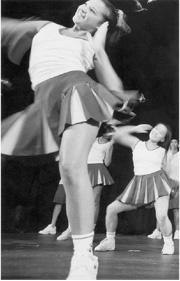“FRESH FLOWERS,” BELLEVUE Art Museum’s new exhibit by 17 artists using floral imagery, is a graceful and devious combination of decoration and concept. On one level, the exhibit is pure joy, bursting with the palette of a new garden. Linger awhile, though, and the show comes across as smooth seduction. Curator Brian Wallace has avoided the usual dissolution of large group shows and gathered together strong, cohesive pieces by artists who see something lurking in flowers beneath their considerable surface beauty.
One of the most thought-provoking works is Wendy Hanson’s A Fleshy Bedcover, a mattress made entirely of dried and stitched rose petals placed on top of a white bed. The bed itself is 6 feet long, but only 22 inches in width—too narrow for an adult body. When I first saw this work two years ago at the Kirkland Arts Center, where it had been grouped with some playful works by other mixed-media sculptors, it struck me as a bittersweet farewell to childhood. While the bed and roses evoked romantic, fairy-tale associations, the narrowness of the structure seemed to suggest that the artist had outgrown such fantasies. At BAM, however, the same work appears much darker in theme. This may be accentuated by BAM’s lighting, but what is most conspicuous this time around are the slight depressions on the surface of the mattress and the discoloration of the rose petals, which have faded to the color of manila folders. Such details signal not only the toll of time, but suggest the absence of a body—an anorectic body. It made me shudder.
Fresh Flowers
Bellevue Art Museum
ends April 11
Flowers inevitably fade, and Hanson’s art calls attention to the glorious physical states in youth to which we can’t return. Her other pieces shown here include fiber sculptures made out of old clothing—or, as she notes on her placards, “clothes that don’t fit.” Her most recent work, Vanity, I’m Told, Is the Last Thing to Go, is a striking wall installation of more than 50 wilting black flowers, with long stems and drooping blooms. (I was instantly reminded of the elderly woman character in There’s Something About Mary, obsessed with hair bleaching and sunbathing even as her skin is shriveled like a raisin.) Many of Hanson’s flowers are missing their petals, left pathetically with tentative pieces of frayed thread. The sewing is intentionally untidy—stitches threaten to come apart, and leftover pieces of thread are long and loose, as disappointing to the eye as your own flaws reflected harshly in the mirror.
The feeling of loss is continued by Laura Vickerson’s Carnation Collar, which, displayed against a red velvet board, immediately conjures up images of church and ceremony. Meticulously constructed, Collar is composed of opposing materials. Delicate lace is covered with a layer of hard wax. (If only one’s faith could be as easily emboldened.) Onto the wax, tiny flower petals are pinned like specimens for a classroom display. It’s a delicious back-and-forth play on the ideas of faith, strength, decay, and preservation. Vickerson’s other piece, Inside Out, is an armor made out of paraffin, modeling waxes, and flower petals. The flowers are unusually employed: Blended into the paraffin and molded to suggest the shape of shoulders, chest, and ribs, the petals appear like layers of muscle.
THERE’S FAR TOO much to contemplate in this wonderful show; what I’ve mentioned is just a small part, and the exhibit is not without moments of comic relief. Ever Is Overall, a two-screen video installation by Swiss artist Pipilotti Rist, begins with deceptively innocent images. A beautiful woman in a flowing dress walks down a sunny street with what appears to be a tall tropical flower. She is smiling radiantly. The adjacent screen shows a lush field populated with the same kind of flower the wo-man is holding. The camera follows the woman in slow motion. She passes by a man and a female cop. They both glance and smile at her, as people tend to do in small towns. She hums a peaceful tune. Then, without changing her expression, she swings the flower and smashes it against a parked car. It breaks the window. She resumes her walk, and smashes three more windows. Each time she hits a car, the music stops and we hear glass shattering. But as suddenly as the idyllic scene was interrupted, it continues, with the woman’s overall composure perfectly intact. The work is a resounding comment on beauty: It has the ability to hide so much—and get away with it.






